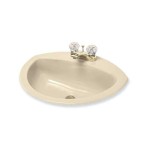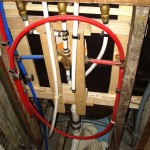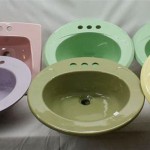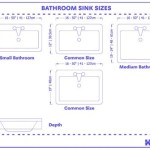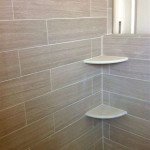Bathroom Sink Plumbing Pipe Size: Essential Considerations
When embarking on a bathroom renovation or plumbing project, understanding the proper pipe size for your bathroom sink is crucial to ensure optimal drainage and prevent plumbing issues down the line. This article delves into the essential aspects of bathroom sink plumbing pipe size, providing comprehensive information to guide you in making informed choices.
Drain Pipe Size
The drain pipe, responsible for carrying wastewater away from the sink, typically ranges from 1-1/4 inches to 2 inches in diameter. Here's a breakdown of common sizes and their respective applications:
- 1-1/4 inches: Ideal for single-sink applications with standard fixtures and average water flow rates.
- 1-1/2 inches: Suitable for larger sinks, fixtures with higher water flow rates, or in situations where the waste line is long or has multiple bends.
- 2 inches: Typically used for heavy-duty fixtures, such as those found in commercial or industrial settings.
Trap Size
The trap, a curved section of pipe beneath the sink, acts as a barrier against sewer gases and prevents debris from entering the drain. The trap size should correspond to the drain pipe size to maintain proper drainage and prevent засоры.
- 1-1/4-inch drain: Requires a 1-1/4-inch trap.
- 1-1/2-inch drain: Requires a 1-1/2-inch trap.
- 2-inch drain: Requires a 2-inch trap.
Vent Pipe Size
Vent pipes allow air to enter the drainage system, preventing pressure buildups and ensuring proper drainage. The size of the vent pipe is determined by the size of the drain pipe and the number of fixtures connected to the system.
- 1-1/4-inch or 1-1/2-inch drain: Typically requires a 1-1/2-inch vent pipe.
- 2-inch drain: Requires a 2-inch vent pipe.
Materials
Bathroom sink plumbing pipes are commonly made from the following materials:
- PVC (Polyvinyl Chloride): Affordable and durable, PVC is a popular choice for both drain and vent pipes.
- ABS (Acrylonitrile Butadiene Styrene): Similar to PVC in durability but slightly more expensive.
- Copper: Offers corrosion resistance and a longer lifespan, but is more expensive than PVC or ABS.
Conclusion
Choosing the correct plumbing pipe size for your bathroom sink is essential for ensuring optimal performance and preventing future plumbing problems. By carefully considering the diameter of the drain, trap, and vent pipes, as well as the materials used, you can ensure a well-functioning drainage system that meets your specific needs.
If you require assistance with determining the appropriate pipe size for your bathroom sink, it is highly recommended to consult with a qualified plumber. Their expertise can provide valuable guidance, ensuring that your plumbing system is properly designed and installed for years of trouble-free operation.

How To Plumb A Bathroom With Multiple Plumbing Diagrams Hammerpedia

Gordee Bathroom Basin Sink Bottle P Trap Brass U Shape 1 4 Inch Slip Inlet Drain Lavatory Adjustable Height Waste Kit Pls Measure Ur Hole Size Before Order Matte Black

This Image To Show The Full Size Version Sink Plumbing Kitchen Diy

Under Sink Injury Prevention S For The Safety Of Wheelchair Users

How To Vent A Toilet Sink And Shower Drain

Rough In Plumbing Bathroom Dimensions Jim The Home Guy

Bathroom Sink P Traps Sanliv Sanitary Wares

Aa Faucet 143 Stainless Steel Bar Sink Drain 1 Nominal Pipe Size 1234buy Com

Pin On Plumbing
What Size Pipe Do You Use For A Sink Drain Quora
Related Posts

